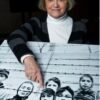“I went on the March of the Living in 1999 and also in 2001 as a survivor but I prefer being called a ‘Witness to History’.
It was with a lot of soul-searching and trepidations that I decided to go on the March. Once I decided I was involved with the preparations, that is, meeting the marchers and speaking to them about my experiences during the war, I got a very good feeling to be with these young people and also the grown-ups (madrichim, bus captains, education staff, etc.)
I knew it would not be easy revisiting Auschwitz-Birkenau where I spent seven months; where my dear mother died on January 4, 1944; where my brother, Jan (Hans), two years my junior, went into the gas chamber on March 8, 1944. My brother volunteered to join my mother on the infamous transport from Terezin at the beginning of September 1943. After six months of survival, these people were then sent to the gas chamber. This operation was called Sonderbehandling. The same fate was destined for us.
When we arrived at the camp on December 15, 1943, we had to sign a paper acknowledging that we would undergo a “Sonderbehandling” or special treatment six months after our arrival (if we were able to survive until then). We knew of course from the September transport that those who survived for six months were then put to death. It was the middle of June, 1944, and our allotted time was coming to an end. Rumours abounded about our fate, so it came as no surprise that we were told that there would be a “selection” in the next few days. We knew that the selection was being conducted regularly in the “D Lager”, the camp for men. How did we know? There was a group of young men, “the Dachdeckers,” who fixed roofs and they travelled from camp to camp. They would tell us what was happening in the camps around us. We were quite well informed about what took place during a selection. Everyone was very upset, especially the old and weak and mothers with small children.
When the day of the “selection” arrived, Mengele and his cohorts (SS Men) were in camp. We were told to line up one block (barrack) at a time, get undressed and carry our clothes on our right arm, visibly exposing our numbers on the left forearm. We walked in front of Mengele and with a flick of his thumb the fate was decided! The ones who were chosen to live went to one side (the SS men wrote down our number) and the others to the other side! Willy, our “Lageralteste”, a prisoner who was in charge of us, told mothers with small children that if they wanted to live, they would have to leave behind their children but of course none of them did.
There was great sadness and despair in the camp. We had to say good-bye to all the people with whom we spent close to seven months, knowing their fate. Our senses by that time were very numb and that was the only way we were able to cope with this horror.
They called out our numbers and we assembled in front of our blocks. They marched us out of the camp and into the “Frauenlager” (women’s camp). We were a very subdued bunch but on the other hand, we were “chosen” to live. As we entered the camp, the orchestra “welcomed” us with a musical performance.
The girls in the Frauenlager were quite jealous of us since we had hair (we were the only prisoners whose heads were not shaven) and then they knew that we would be shipped out quite soon. In a few days we were being divided and some of us went to Hamburg and the others to Stutthof. What a miracle we left Auschwitz-Birkenau – we were born again!
Almost fifty-five years later, returning to Birkenau following the 3-kilometer March from Auschwitz to Birkenau with young people from different countries was uplifting and at the same time, very emotional. I was asked to address the students in one of the barracks, the only one left standing, but when I arrived on the grounds of Birkenau I literally collapsed; it seemed that I heard all the voices from the past and I just fell down. I was helped up and got back my determination to fullfil my duty. I addressed the children (as I call them) and gave them a glimpse of life in Birkenau. We continued with the visit to all the other horrible places and I tried to be there for the students when they needed me. This was my first March and then I went again in 2001.
Why do I do what I do, to be involved in the education of the Holocaust? Unfortunately, every year there are fewer and fewer of us left and we have to try to do our best to inform and educate the young people.
I am also a speaker for the “Montreal Holocaust Memorial Centre” and visit many schools. Sometimes I am asked, “Do you feel guilty that you survived?” and my answer is “NO”. I feel we are all put on this earth for a certain purpose and I was chosen to speak for the 6,000,000 whose voices were stilled.”
Montreal, Ontario
Participated on the March in 1999 and 2001.






